This post may contain affiliate links. Please read our disclosure policy. As an Amazon Associate, I earn from qualifying purchases.
Tsoureki or Greek Easter Bread is an enriched, brioche-like sweet bread. A delightful flavor comes from the essence of citrus and a spice called Mahlab. This soft fluffy bread is terrific for breakfast and makes fantastic French toast casseroles and breakfast strata.
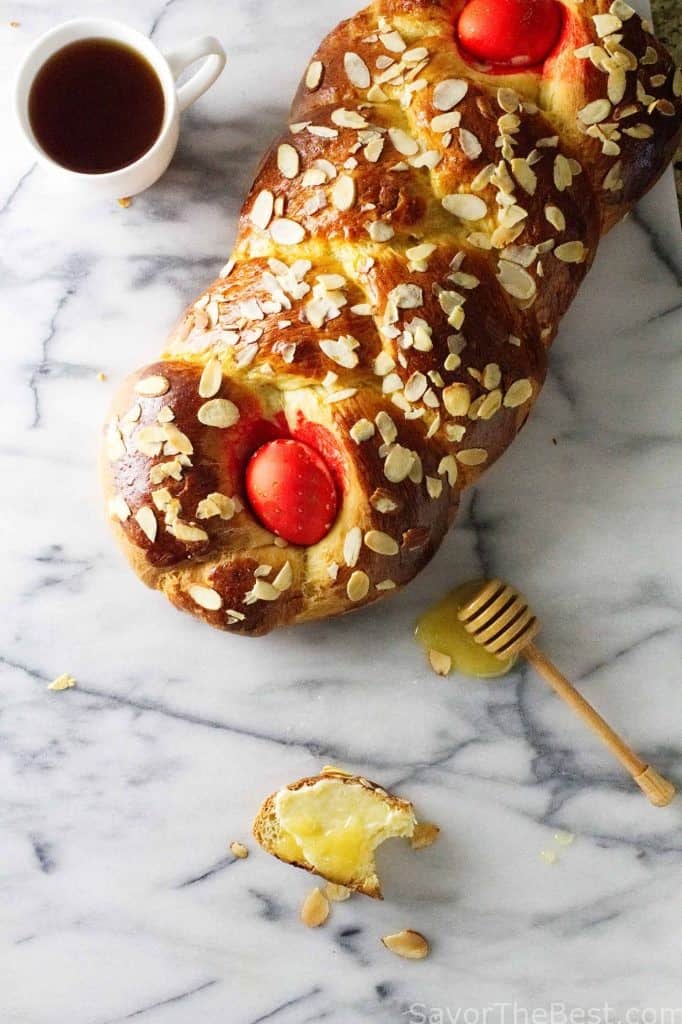
Greek Easter Bread (Tsoureki)
Although this Greek sweet bread is called Easter bread, Tsoureki is associated with other holidays like Christmas and New Year and is certainly appropriate to eat all year long.
It is traditional to make the bread for Easter because of its symbolism (you can read about that below). However, it gets baked throughout the year without decorating it with a red egg.
Another traditional time to bake Tsoureki is during the New Year’s celebration when a coin gets hidden inside the bread instead of topped with red eggs.
The most unique thing about Tsoureki and what sets it apart from brioche bread is the addition of a spice called Mahlab.
Mahlab comes from the seeds of a cherry that is native to the Mediterranean. Although it is optional, mahlab gives the bread a unique subtle fruity flavor and really sets this bread apart from other decadent, sweet bread recipes. You can find it in Mediterranean markets or online.
Some recipes also call for mastic. We did not include mastic in this recipe because a single serving will cost almost $20 and provide minimal (if any) flavor to the bread.
Here is Why This Recipe Works
- Jump starting the batter with a sponge helps develop the flavor and texture of the sweet bread.
- Eggs, butter, and whole milk give the bread a rich flavor and soft, tender texture.
- The traditional flavor of Tsoureki comes from the addition of Mahlab and citrus zest.
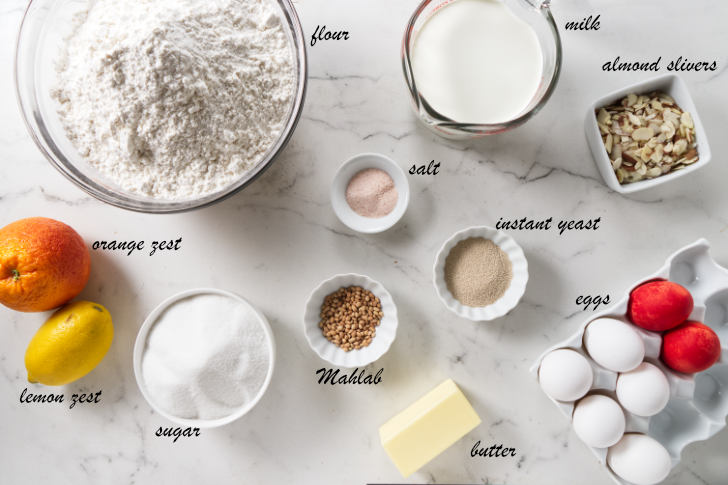
The Ingredients
Here is a list of the ingredients you will need for this Greek sweet bread. Scroll down to the printable recipe card for all the details.
- Bread flour. You can use all-purpose flour but bread flour will give you the classic Tsoureki bread texture.
- Instant dry yeast. You can substitue the Instant yeast for active dry yeast by increasing the amount to 5 teaspoons.
- Sugar. Use standard, granulated white sugar.
- Milk. Whole milk warmed up to about 105°F works best.
- Mahlab. Also known as Mahlepi. Try to purchase mahlab whole and grind it yourself. Pre-ground mahlab can go rancid quickly.
- Butter. You can use salted or unsalted butter. The small amount of salt in salted butter will not effect the recipe.
- Eggs. Let the eggs sit out at room temperature or stick them in a bowl of warm water for a few minutes.
- Salt. We used regular table salt. If you use Kosher salt, you will want to increase the amount.
- Orange zest and lemon zest. Use a microplane to create small pieces of zest that will distribute throughout the dough better than large chunks.
As mentioned above, you can add mastic to the dough if you have a few extra bucks to squander. If you are interested in enhancing the flavor more, we recommend adding extra citrus zest, a bit of vanilla extract, or increasing the amount of mahlab.
Another addition that goes well with this sweet bread is dried fruit. You can add currants or raisins but I especially love to chop up candied lemons or oranges.
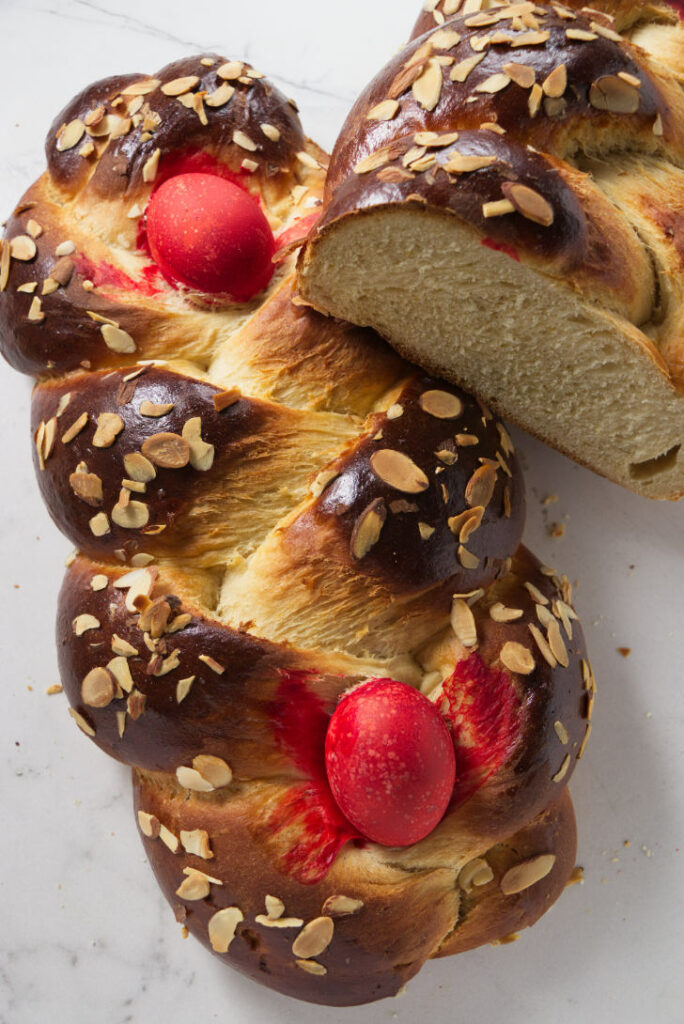
The Symbolism Of The Bread
The bread itself is laden with symbolism. It has a three-strand braid to represent the Holy Trinity, the Father, the Son, and the Holy Spirit.
The hard-boiled eggs get dyed red to symbolize the Blood of Christ. The egg is also a symbol of renewal and rebirth.
An egg wash gives it a shiny coating that symbolizes the Light of Christ.
For another recipe that has ingredients that symbolize Easter, try our empty tomb cookies.
Substitutes For Mahlab Spice:
Like most yeast bread it takes some time to make but is well worth the effort. If you can’t find Mahlab spice just omit it or perhaps substitute it with some cardamom, which will give the bread a unique depth of flavor. Vanilla extract also can be used for a lovely essence in this bread.
Over-Cooked eggs:
The hard-boiled eggs get a bit overcooked and rubbery by the time the bread is baked. If you plan to eat them, you can start with raw eggs which I have done in the past. They will still become a tad overcooked but will make an excellent egg salad.
Mostly, the eggs are there for symbolism so I don’t worry about how rubbery they get by the time the bread finishes baking. If you really want some nice hard-boiled eggs, just make a few extra.
Some people don’t like to add the colored eggs prior to baking the bread because the red dye will bleed into some of the bread. I think that adds to the symbolism of the bread because it reminds me of the spilled blood of Jesus Christ.
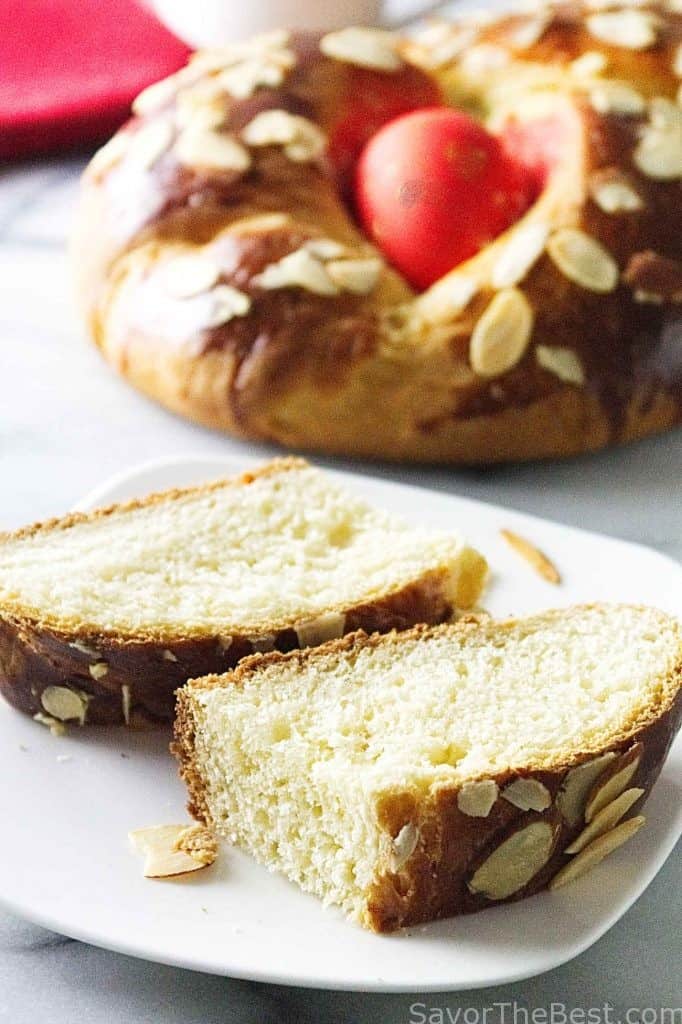
How To Make Tsoureki Bread
Here is a brief overview to get an idea of what to expect when you make this Greek Easter bread. Scroll down to the printable recipe card for all the details.
- Make a sponge or thin batter using the milk, yeast, and just a portion of the flour and sugar. Let the sponge sit for a while to develop.
- Mix in the rest of the ingredients, adding the flour in increments. Knead the dough until it gets smooth.
- Place the dough in an oiled bowl and let it rise.
- Divide the dough into two equal sextions then divide each half into three sections. Roll the sections into ropes then braid three ropes together. Repeat with the other three ropes. Place the red hard boiled eggs on top and let the two braided loaves rise.
- Coat the loaves with an egg wash then sprinkle slivered almonds on top and bake.
This bread has so much flavor it is great on its own but it also tastes good with sweet or savory spreads. Spread it with homemade strawberry fig jam, a savory labneh spread, or nut butter.
You can serve it with a hearty breakfast like our mushroom quiche or part of a Greek dinner along with our Greek lamb shanks, stuffed grape leaves, and Greek salad with a creamy Greek dressing.
More Artisan Bread Recipes
- Beer Pretzel Bites
- Navajo Fry Bread (Two Ways!)
- Einkorn Naan with Garlic and Onion
- Quick Bread Pizza Dough
- 21 Artisan Bread Recipes
Helpful Tips
- Do not add extra flour. The dough is sticky. If you are not familiar with working with sticky dough, you may be tempted to add extra flour. If you add too much flour, the bread will not be as soft and tender.
- Oil your hands and the counter to make it easier to work with the sticky dough. The dough will not stick to our hands or the counter as easily if you keep them lightly oiled. If you don’t want to add oil to your countertop, you can dip your hands in water.
- Use a bowl scraper and a bench scraper to clean the work surface. I can’t express how helpful these items are, especially the bench scraper.
- When you roll the dough into logs, taper the ends to make it easier to finish the braids.
- If the dough tries to spring back when you roll it into logs, set it aside and let it rest for a few minutes. It will roll easier after it rests.
Why We Celebrate Easter
Easter is the time we celebrate God’s love and sacrifice for us. God sent His son Jesus Christ to the world to pay for our sins. 1 John 4:9 says “this is how God’s love was revealed to us: God sent His one and only Son to us so that we might live through Him.” Jesus Christ paid the price for our sins that we could not pay for through our own actions, thoughts, or power.
He knew that no matter how hard we try, we could never be pure, righteous, or holy enough to be in the presence of God. By God’s grace, He offers the gift of salvation through faith in Jesus and the blood that He shed for us.
It is a free gift to anyone who accepts it and enters into a personal relationship with God. Once you accept this gift of salvation, God sees you in a new way as he looks at you through the sacrifice that Jesus made for you. You have been covered and protected by His blood.
I hope this Easter you have assurance, peace, and hope in the knowledge that not only did He die for you, but He concurred death through His resurrection. “He is risen”.
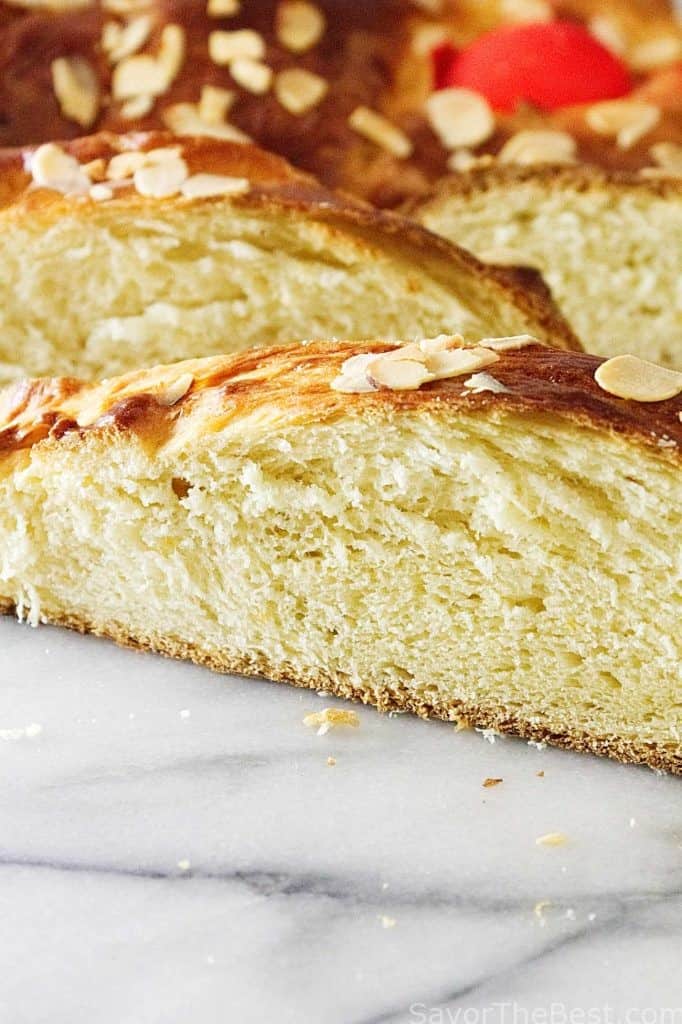
Not Just For Easter
Greek Easter Bread doesn’t have to come around on Easter. Keep this recipe on file to make throughout the whole year. You’re going to love this sweet, rich bread. It is especially delicious for breakfast with a cup of coffee or lavender tea. And when you pop a slice in the toaster, it will make the whole house smell like a bakery.
If you have leftovers, this bread is perfect for bread pudding. It’s sweet enough to use in any dessert-based dish but it also compliments savory foods.
Some Other Recipes You Might Like:
This soft, rich bread einkorn bread gets enriched with milk and sweetened with honey. It’s soft, light, and delicious.
This sweet potato flatbread only uses three ingredients. It’s simple to make and doesn’t require yeast, kneading or patience to wait for the doughs to rise.
This is a wonderful, dark, sprouted rye bread with complex flavor and texture. We added caraway seed for extra distinction.
Pin this now to find it later!
Pin It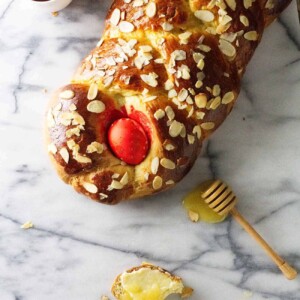
Greek Easter Bread (Tsoureki)
If you make this recipe, please leave a star rating and comment.
Ingredients
Makes 2 Loaves
- 9 to 10 cups bread flour, divided; 1080 to 1200 grams
- 4 teaspoons instant dry yeast
- 1½ cups granulated sugar, divided; 300 grams
- 2 cups warm milk, 472 grams
- 2 teaspoons ground Mahlab, optional
- 8 tbsp. butter, melted and cooled
- 5 large eggs, room temperature, well beaten
- 2 teaspoons salt
- 2 tablespoons orange zest
- 1 tablespoon lemon zest
Topping
- 1 large egg, beaten
- 4 to 6 hard boiled eggs, dyed red
- ¼ cup slivered almonds
Instructions
- Add 2 cups of the flour, all of the yeast and 1/2 cup of the sugar to a bowl. Next, add the warm milk and mix (by hand or with a mixer) until all the lumps are gone (you will have a very thin mixture). Cover the bowl and let it stand for 30 to 45 minutes. This will develop the sponge and give the yeast a jump start.
- Add the melted butter and eggs and mix well. Pour 5 cups (600 grams) of flour, the salt, remaining 1 cup of sugar, ground Mahlab, orange and lemon zest to the dough and mix thoroughly to blend all the ingredients.
- Slowly add the remaining 2 to 3 cups of flour to the dough and knead for about 10 minutes. If you are not using a stand mixer then turn the dough out onto a lightly greased surface and knead by hand. The dough will be very soft and sticky but will get easier to work with after a long knead. It will also become firmer after it proofs. If you are tempted to add more flour, wait until after it proofs.
- Form into a ball and place in a lightly greased bowl. Cover with a clean dishtowel and set aside to rise for 1 ½ to 2 hours.
- Place the dough on a floured work surface. Divide into 6 equal sections, rolling each section into ropes about 15" long. For each loaf, braid 3 ropes, then press the eggs into each braid. Set bread aside to rise again for 1 hour on a greased baking sheet.
- Preheat oven to 350˚. Brush bread with beaten egg, sprinkle with slivered almonds and bake until golden, 40–50 minutes
Video
Notes
- This recipe uses instant yeast. Using instant yeast eliminates the need to dissolve and proof the yeast prior to mixing the ingredients. Just toss the ingredients together and mix well. If you want to use active dry yeast, increase the amount of yeast to 5 teaspoons.
- The milk should be warmed to about 100° to 110°. I don't use a thermometer for this, I simply warm the milk until it is comfortably warm to the touch.
- Working with sticky dough: If you grease your hands and the countertop with a bit of olive oil, the dough will be easier to knead. The oil will prevent the dough from sticking to your hands or the counter and you won't be tempted to add too much flour. A bowl scraper and a bench scraper are also great tools to use with sticky dough.
- It is best to buy Mahlab whole and grind it as needed because the flavor starts to deteriorate within days after it is ground. Given enough time, ground mahlab will become rancid. Simply place the whole seeds in a spice grinder or use a mortar and pestle. If you can not find whole Mahlab then make certain the package is well sealed. If you can not find Mahlab or don't have time to order it, cardamom or vanilla extract make lovely substitutes. They don't have the same flavor as Mahlab but they give it an extra depth of flavor.
- Some recipes use mastic in the Tsoureki bread dough. We did not include mastic because it is very expensive and in my opinion, does not add a detectible flavor.
- If you want to add dried fruit, you can add up to 1-1/2 cups of chopped dried fruit or raisins to the dough.
- When you roll the dough into logs, sometimes the dough tries to spring back and resists shaping. If that happens, set the log aside and let it rest for a few minutes. After it rests, it will be easier to shape.
- Taper the ends of the logs. The thinner ends will make it easier to start and finish the braids and give the loaves a nicer shape.
Nutrition
Nutrition information is automatically calculated, so should only be used as an approximation.
 Like this recipe? Rate & comment below!
Like this recipe? Rate & comment below!You can see our Web Story here.
We first published this recipe on April 12, 2017. We updated the post with new photos, some helpful tips, and a video.
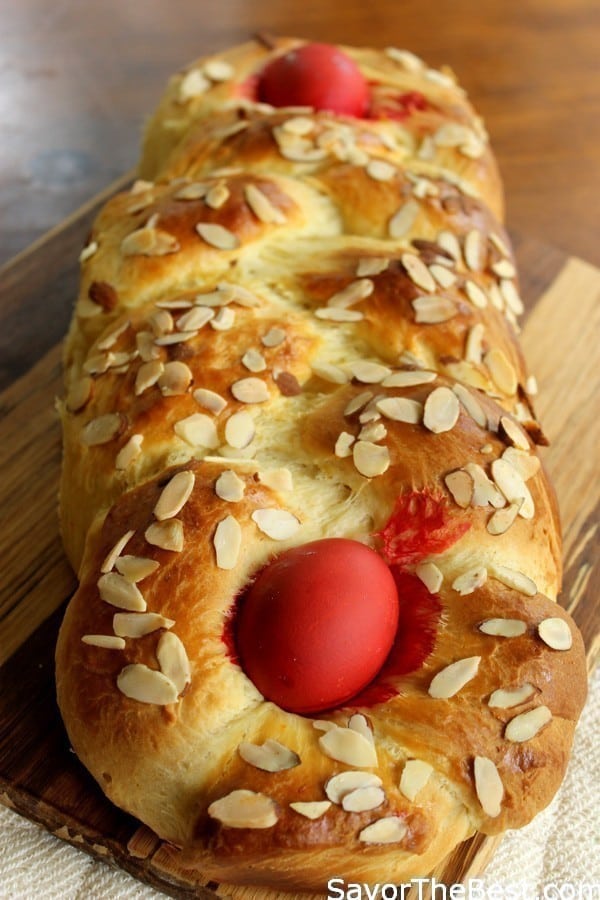

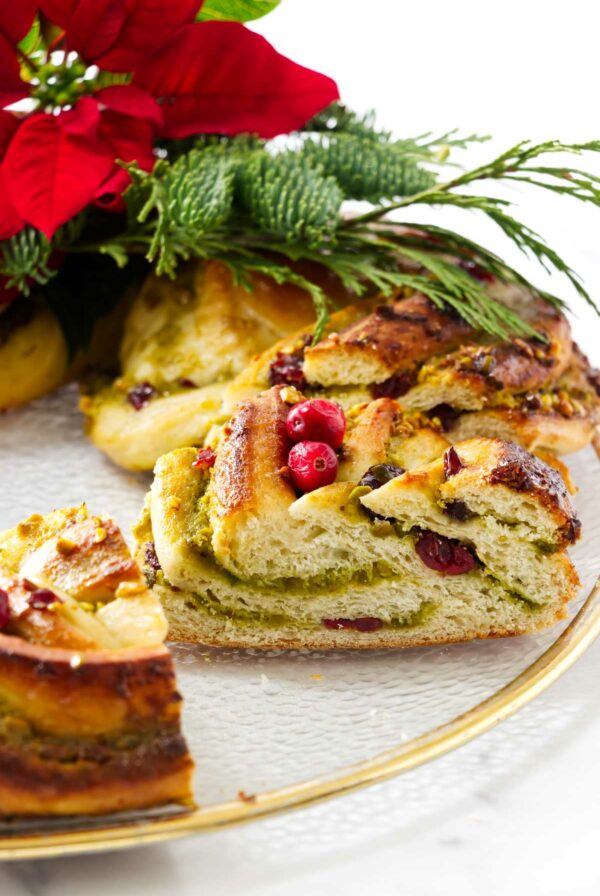

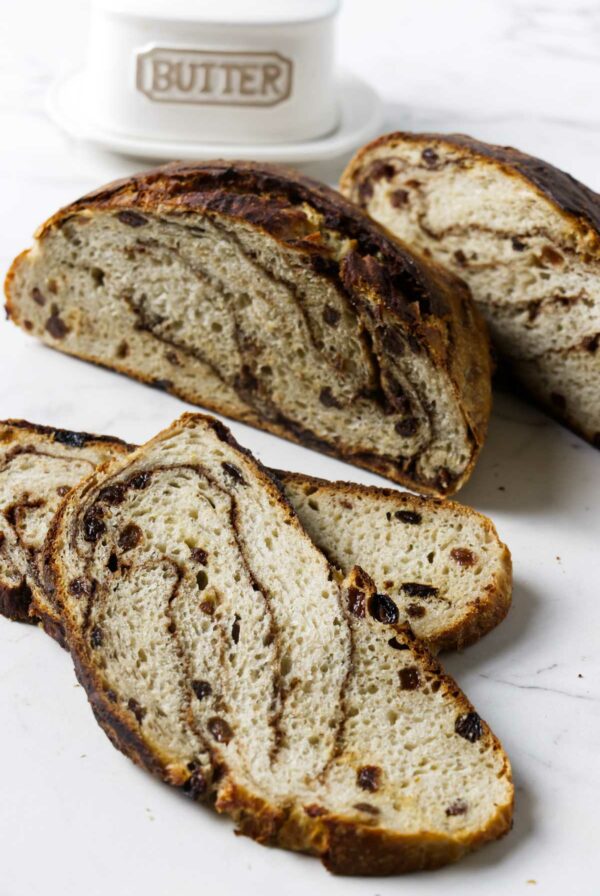
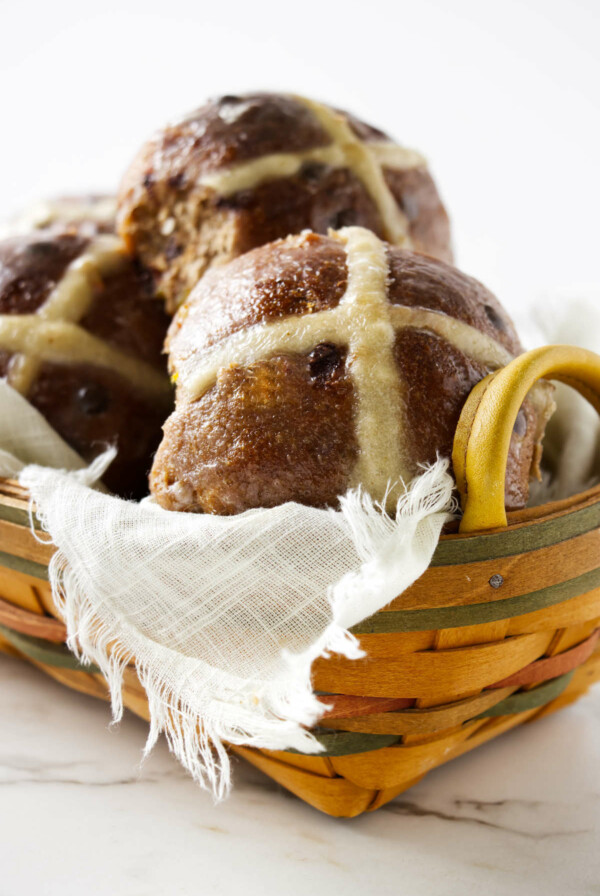










I made this last Easter and really impressed my friends! It was every bit as delicious as my beautiful Greek mother used to make. Can I freeze the dough should I just freeze the baked bread? It makes 2 gigantic loafs and too much for us to eat before going stale.
Thank you so much!
That’s a great question. Technically, you CAN freeze the dough before baking. However, I have not tried it with this dough. I have found that sweet, rich dough like this one does not freeze and thaw as well as lean dough with less sugar and fat. If you do try it, I would recommend adding an extta teaspoon of yeast to the dough and freezing the dough after the first rise. Let it thaw at room temp and go through the second rise just before baking it.
Otherwise, the baked bread will freeze very well and this is what I do. If you keep it in a freezer proof bag and try to get as much air out as possible, it will freeze for 3 to 4 months.
can I bake this in a 12 inch round loaf pan ? this the way my grandmother did it
Yes, you can. You will need two pans for this recipe. Thanks for the question.
This is the best Tsoureki I have ever made! I am Greek and am always looking for a good Tsoureki recipe to make for Easter and this one is perfect! Probably the one I will use from now on! Thank you so much.. I’m in the process of making my second batch for my in-laws rights now!
Hooray!! Thanks for the comment. I hope your in-laws love it as well.